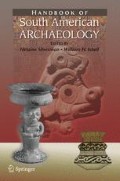The dog (Canis familiaris) was already domesticated when early humans entered the western hemisphere. Over the ensuing millennia Native Americans domesticated comparatively few indigenous animals, in contrast to the many animals that were genetically and behaviorally modified from their wild ancestors through captive controlled breeding in the Old World. New World animal domesticates included only two large birds (the turkey in North America and muscovy duck, Cairina moschata, from Mexico south into South America), a medium-sized rodent (guinea pig, Cavia porcellus), and two camelids (llama, Lama glama, and alpaca, Vicugna pacos). Diamond (1999) explains this by suggesting that relatively few candidates appropriate for domestication survived the massive extinctions of the terminal Pleistocene, and that geographical peculiarities of the western hemisphere inhibited the subsequent diffusion of domesticates from their areas of origin.
Access this chapter
Tax calculation will be finalised at checkout
Purchases are for personal use only
Preview
Unable to display preview. Download preview PDF.
References
Archetti, Eduardo P., 1997, Guinea-pigs. Food, Symbol and Conflict of Knowledge in Ecuador. Berg, Oxford.
Diamond, Jared, 1999, Guns, Germs, and Steel. The Fates of Human Societies. W.W. Norton, New York.
Donkin, R. A., 1989, The Muscovy Duck, Cairina moschata domestica. Origins, Dispersal, and Associated Aspects of the Geography of Domestication. A.A. Blakema, Rotterdam.
Franklin, William L., 1982, Biology, ecology, and relationship to man of the South American camelids. In Mammalian Biology in South America, edited by M.A. Mares and H.H. Genoways, pp. 457–489. Pymatuning Laboratory of Ecology Special Publication 6. University of Pittsburgh, Linesville.
Hückinghaus, Folkhart, 1962, Vergleichende untersuchungen die formenmannigfaltigkeit der unterfamilie caviinae Murray 1886. Zeitschrift für Wissentschaftliche Zoologie 166:1–98.
Morales, Edmundo, 1995, The Guinea Pig. Healing, Food, and Ritual in the Andes. University of Arizona Press, Tucson.
Pacheco Torres, Victor R., Alfredo Altamirano Enciso, and Enma Guerra Porras, 1986, The Osteology of South American Camelids. Institute of Archaeology, Archaeological Research Tools, Vol. 3. University of California, Los Angeles.
Stahl, Peter W., 2005, An exploratory osteological study of the Muscovy duck (Cairina moschata) (Aves: Anatidae) with archaeological implications for neotropical archaeology. Journal of Archaeological Science 32: 915–929.
Wheeler, Jane C., 1995, Evolution and present situation of the South American camelids. Biological Journal of the Linnean Society 54: 271–295.
Wing, Elizabeth S., 1986, Domestication of Andean mammals. In High Altitude Tropical Biogeography, edited by F. Vuilleumier and M. Monasterio, pp. 246–264. Oxford University Press, New York.
Author information
Authors and Affiliations
Editor information
Editors and Affiliations
Rights and permissions
Copyright information
© 2008 Springer Science+Business Media, LLC
About this chapter
Cite this chapter
Stahl, P.W. (2008). Animal Domestication in South America. In: Silverman, H., Isbell, W.H. (eds) The Handbook of South American Archaeology. Springer, New York, NY. https://doi.org/10.1007/978-0-387-74907-5_8
Download citation
DOI: https://doi.org/10.1007/978-0-387-74907-5_8
Publisher Name: Springer, New York, NY
Print ISBN: 978-0-387-74906-8
Online ISBN: 978-0-387-74907-5
eBook Packages: Humanities, Social Sciences and LawSocial Sciences (R0)

